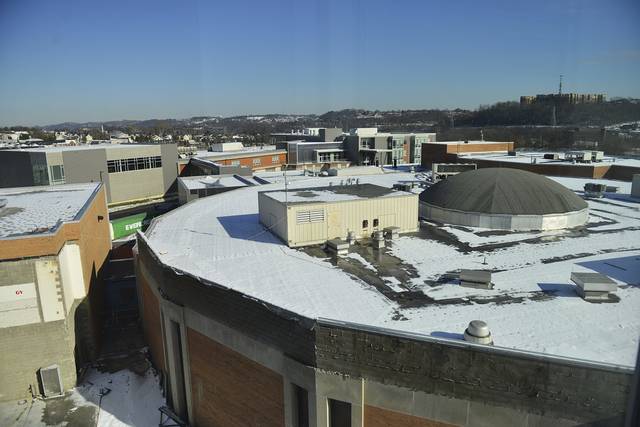https://triblive.com/local/carlynton/new-high-school-at-cv-gets-rave-reviews-from-students-teachers/
New high school at CV gets rave reviews from students, teachers

Laughter — and lots of chatter — can be heard across the large commons area at the new Chartiers Valley High School, one week after the school’s opening.
Principal Patrick Myers smiles as he looks down from a hallway two floors above, that’s encompassed by a railing and open to overlook the school.
The new Chartiers Valley High School, which opened to the school’s 1,000 students on Jan. 7, with a price tag of slightly more than $51 million, doesn’t look like your typical high school. But, that’s the point.
“It’s innovative. It’s a different type of space,” Myers said. “The goal was to really think outside the box and not come up with your standard brick and mortar.”
Students and staff had a say in what they wanted to see in the building, even speaking with architects and designers prior to construction.
The school is a reflection of that.
“It’s crazy how modern it is and how much it’s related to us and built for us,” said junior Sara Hinnebusch, 16.
The four-story school features the main commons area and two classroom wings.
The classrooms are divided into eight learning communities, or interdepartmental houses. Each has a social studies, math, science and English classroom, a joint faculty office, a smaller commons space and an area for small group learning.
Each learning community also has an area for lockers and its own bathrooms, so students don’t need to be wandering the halls during class periods.
The learning communities are senior Christian Stein’s favorite part of the school.
“It doesn’t look like a school and that’s a good thing,” said Stein, 18, a senior. “The old schools just look outdated and this school just looks like it belongs in 2019…. The space looks so welcoming and new and nice, I just feel like it will inspire learning.”
The learning communities are similar to the ones that debuted at Chartiers Valley Middle School when it opened during the 2017-18 school year.
Unlike the middle school, however, high school students won’t stay in one learning community for the entire day. They’ll move throughout the building for classes.
Having multiple subjects taught from one contained area allows for increased collaboration, Myers said.
“We want teachers to be able to work together, to talk,” he said.
While the commons area may have been noisy at lunch time, just two doors away, in the heart of a learning community, not a sound could be heard. Acoustics was a big part of the construction of the school, Myers said.
Technology also was important.
Every classroom now has an interactive, touch-screen Promethean board. Many are enclosed in cabinets that are outlined by whiteboards.
In the science classrooms, however, the walls are the whiteboards.
Charts, in red and green, line the walls of Susan Marino’s physics classroom.
She was able to share the data from the prior week’s labs with her students and leave it on the walls so they could discuss it further.
She’s most excited about having a lab space in the classroom. Before, teachers shared a lab that was down the hall. If Marino was talking about something with her students and she wanted to show them, she’d have to have them grab their things and hope the lab wasn’t in use.
Now, as they’re learning, she says, “OK! Let’s go back and try it!”
“The kids are loving it. The kids are benefiting,” Marino said.
Large windows can be found all throughout the building. Many of the core classrooms, even, have a pop-out section that’s encased by windows.
Social studies teacher Frank Brown says he’s already noticing that students are more engaged. He credits the natural light for that.
“I truly believe that and I know it’s simple,” he said. “It really impacts their moods and their efforts.”
It’s a big change from the old Chartiers Valley High School, where the building was a circular shape. The interior classrooms had no access to sunlight and there was limited visibility.
For the last year-and-a-half, high school students had classes at the old middle school — also a circular building — while the new school was being built.
The new high school has opened in phases.
The Applied Engineering and Technology wing opened more than a year ago. That includes a clean and a dirty makerspace, where students have access to everything from a plasma cutter to 3D printers. They design then create and build full-scale products.
The stadium wing, which was completed in the mid-2000s, also remains. The old gymnasiums and pool also are staying.
To pay tribute to the old high school, there’s even an outline of where the old building sat engraved into the floor of the commons area.
Construction still isn’t finished. The old cafeteria space will be demolished, along with the old middle school. The area that now houses the old middle school will become the high school offices.
All construction likely will be finished by December 2019, Myers said. That doesn’t include landscaping and outdoor work.
There’s still more to be done inside the new school, too.
The principal’s advisory council, comprised of students and teachers, is working on naming spaces — like the commons area — and finding ways to fill the walls.
“There’s a lot that we want to do to make it our own Chartiers Valley, around our culture, around our message,” Myers said.
Stephanie Hacke is a Tribune-Review contributor.
Copyright ©2025— Trib Total Media, LLC (TribLIVE.com)
